How I Developed This Recipe
Curry rice might be the most well-known Japanese curry dish, but Japan has come up with a bunch of new and creative takes on this popular comfort food. One of these is curry nabe (hot pot), which takes the regular curry flavor and turns it into a hearty, communal dish.
This recipe has lots of layers of flavor. It starts with a delicate kombu broth base, then gets deeper with chicken drumsticks and shrimp. The end result is a creative yet approachable dish that captures the essence of curry in hot pot form.
Best of all, this hearty and satisfying meal comes together easily using simple curry powder. It’s the perfect way to warm up on a chilly winter evening, getting the whole family or friends around a steaming pot of aromatic curry!
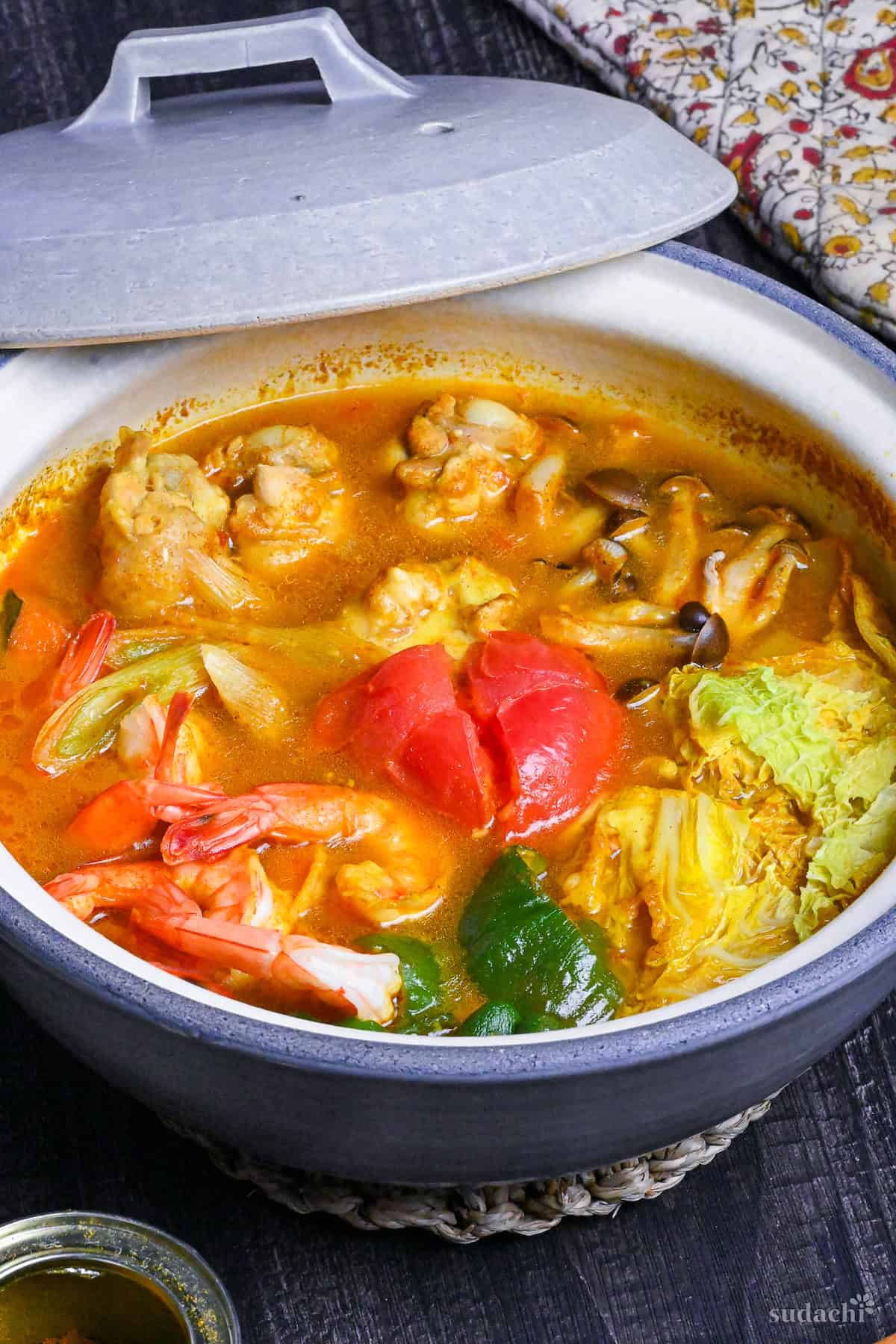
Key Ingredients & Substitution Ideas
- Kombu (dried kelp): This is the base of our tasty broth. It’s an essential Japanese ingredient that adds rich umami flavor to the hot pot, creating a complex base that makes the whole dish better.
- Drumsticks & Shrimp: These proteins work double duty-the chicken bones enrich our broth while the meat becomes tender and succulent, and the shrimp adds a delicate sweetness and another layer of flavor.
- Tomato: It adds a nice balance of natural umami and acidity to the curry.
- Napa cabbage (Chinese cabbage): A great choice because of its natural water content and sweet flavor, which enhance the broth beautifully. Regular green cabbage works well too.
- Pumpkin (kabocha or butternut squash): It adds natural sweetness and helps thicken the broth. I love using kabocha for its rich flavor, but butternut squash makes an excellent substitute.
- Additional Vegetables: You can use whatever mushrooms you like (I used shimeji, but any variety works well), carrots, bell peppers, and Japanese leeks (or regular leeks).
- Broth Seasonings: Soy sauce, sake, mirin, curry powder (I used Japanese one, but you can use any variety), chicken bouillon powder, chili bean paste (doubanjiang), and melty cheese (either cheddar, gouda, or a mix of both).
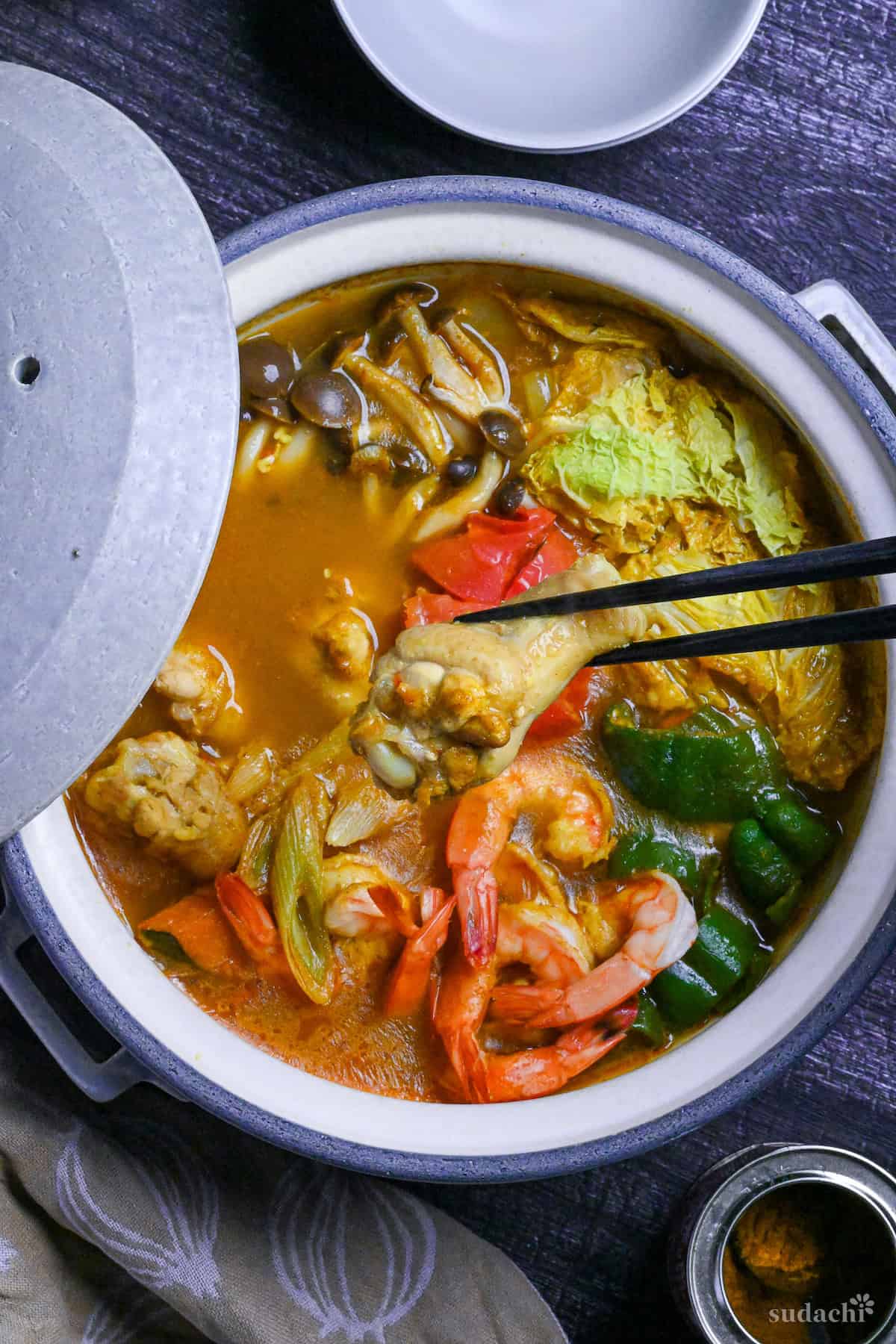
Visual Walkthrough & Tips
Here are my step-by-step instructions for how to make Curry Nabe at home. For ingredient quantities and simplified instructions, scroll down for the Printable Recipe Card below.
This section aims to provide a comprehensive overview of the cooking steps and techniques with visuals. It also includes more in-depth tips and tricks and explains why I do what I do.
Place the kombu in a large pot and cover with cold water. Let it steep at room temperature for at least 30 minutes to get the most out of the umami flavor.
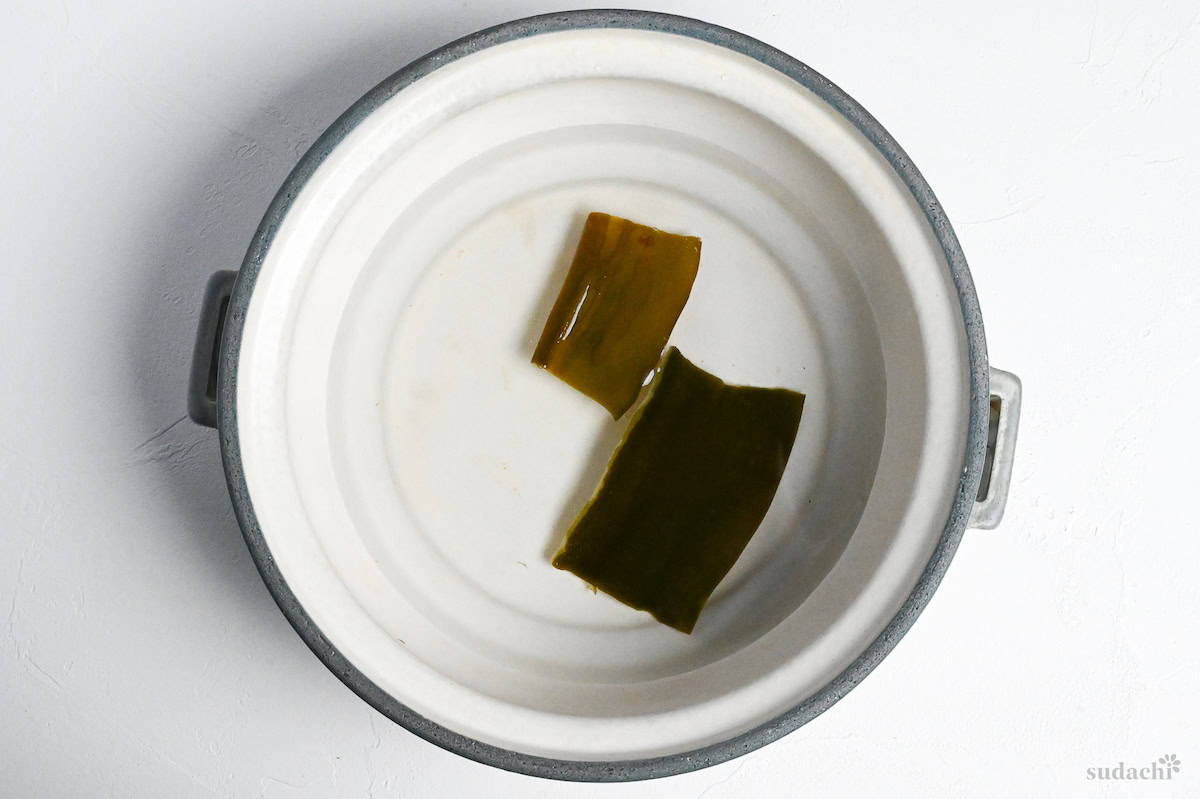
Add the drumsticks to the pot and heat over medium heat until it’s almost boiling. When small bubbles appear around the edges, remove and discard the kombu.
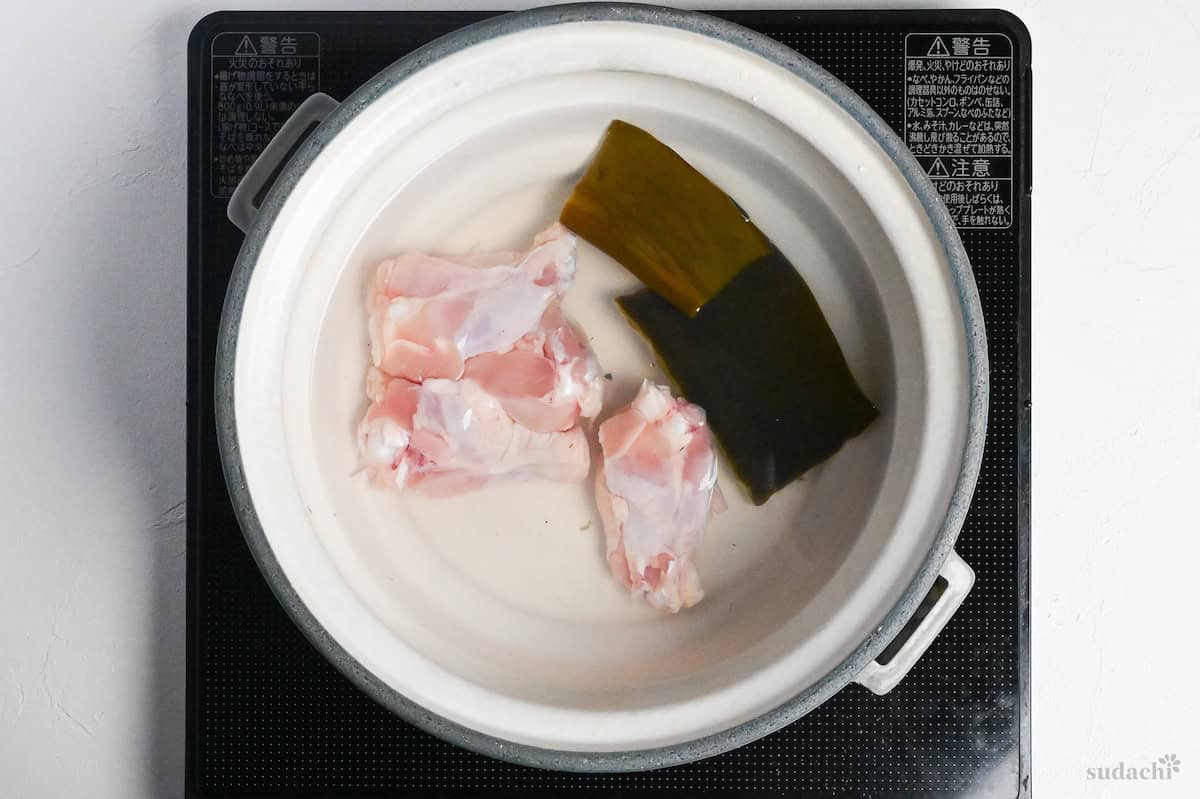
Skim off any foam that rises to the surface to ensure a clear and clean-tasting broth.
Now, add the pumpkin and carrots to the pot. These dense vegetables need more cooking time to get tender and soak up that broth. If you plan to use other hardy root vegetables, add them here.
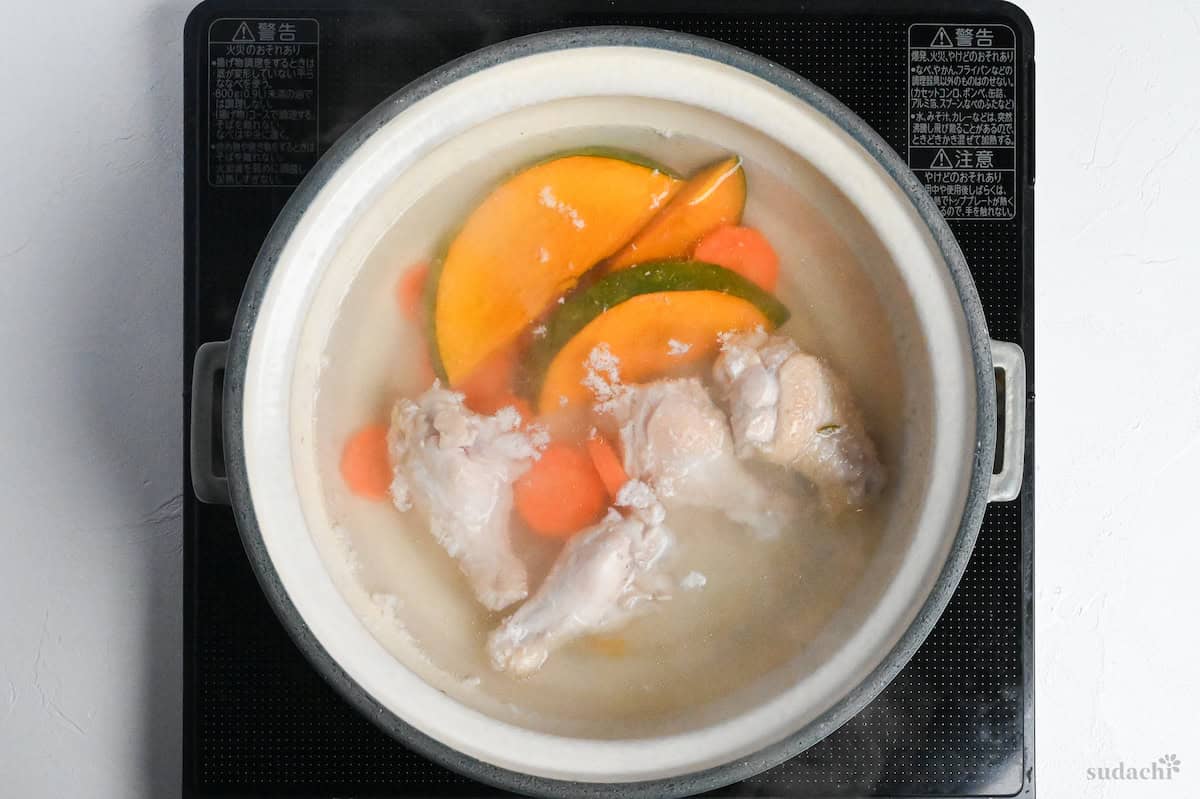
Cover and simmer over low to medium heat for about 5 minutes.
Add the rest of your vegetables, shrimp, seasonings, and cheese to the pot. Give it a gentle stir to mix everything together, but be careful not to overdo it and break up the ingredients.
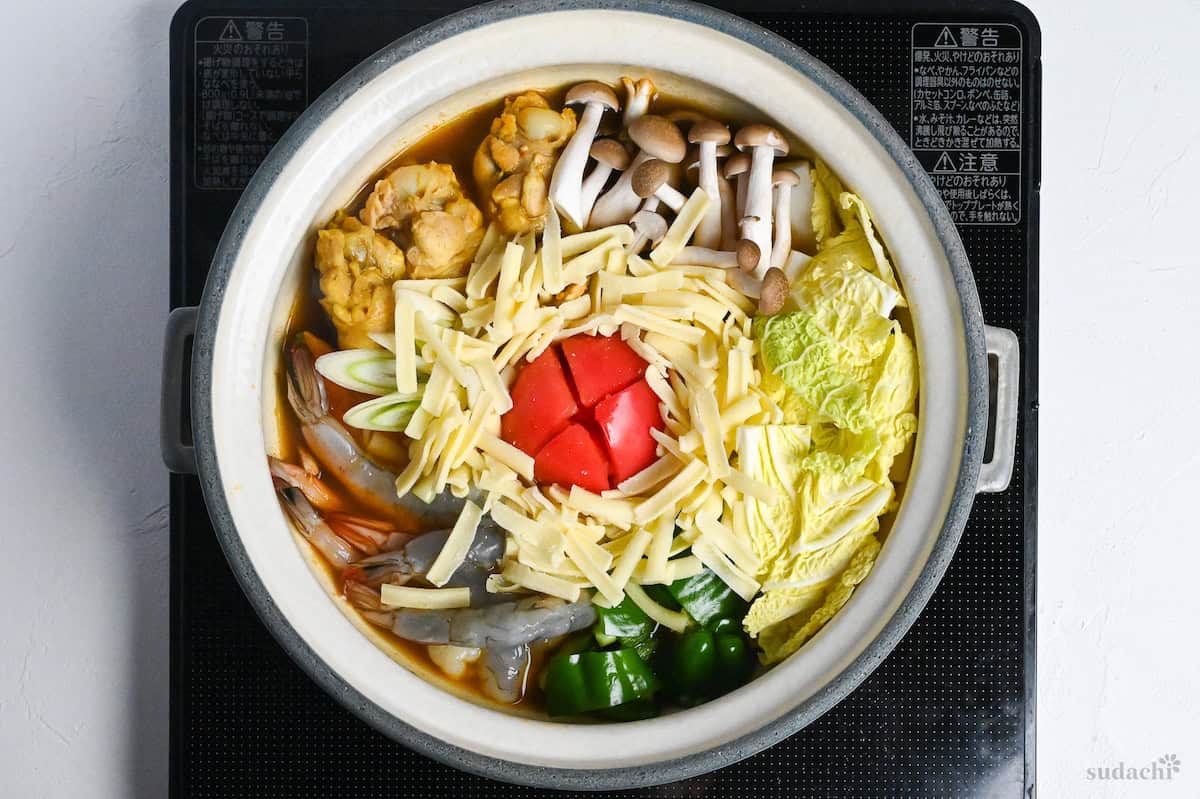
Cover and simmer for another 5-10 minutes or until the shrimp and chicken are cooked through. The vegetables should be tender but still hold their shape.
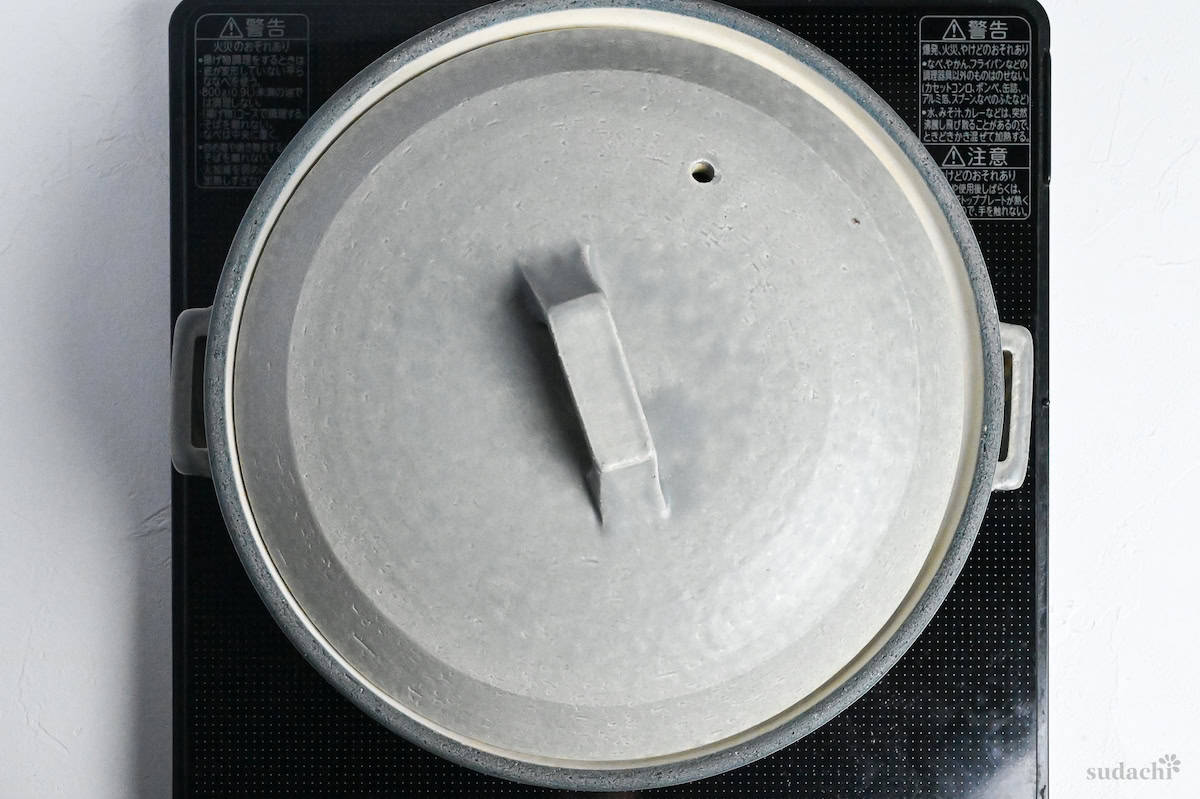
Pour the hot pot into individual bowls, making sure each one has a good mix of proteins, vegetables, and broth.
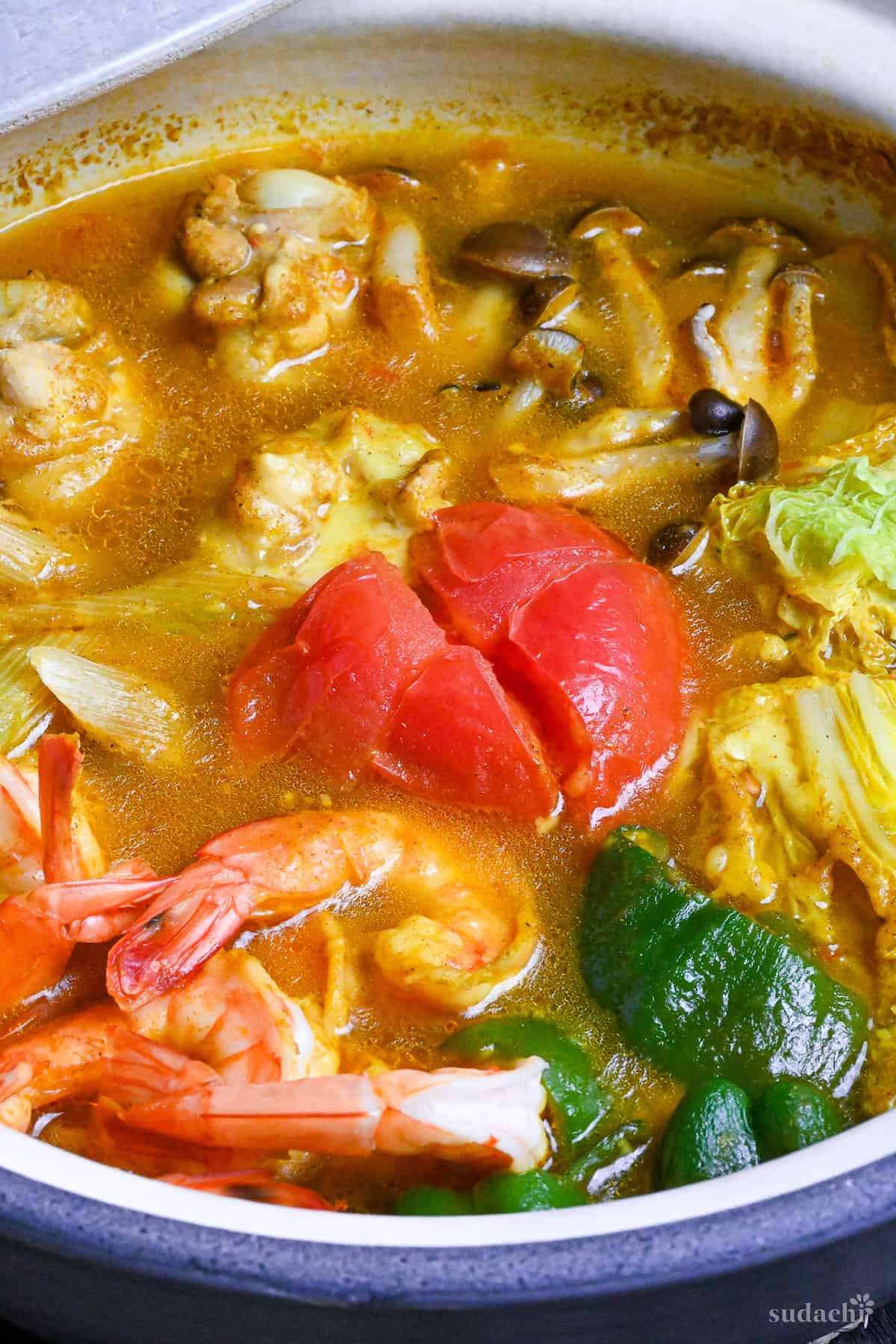
When you’re done with all the ingredients, cook the ramen or udon noodles in a separate pot following the package instructions. Drain and rinse them under water to get rid of the excess starch, then toss them into the rest of the curry broth.
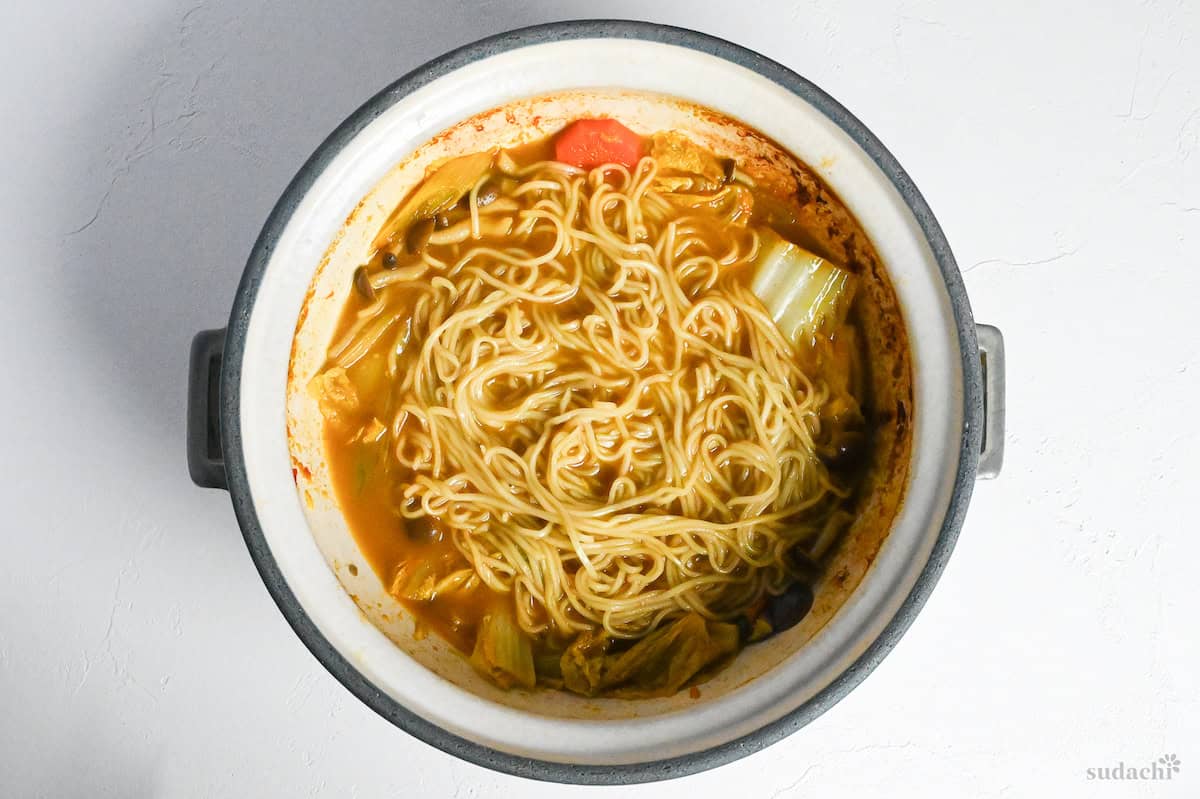
This hot pot finish will transform the leftover broth into a satisfying noodle course.
Jump to Full Recipe MeasurementsI hope you enjoy this recipe! If you try it out, I’d really appreciate it if you could spare a moment to let me know what you thought by giving a review and star rating in the comments below. It’s also helpful to share any adjustments you made to the recipe with our other readers. Thank you!
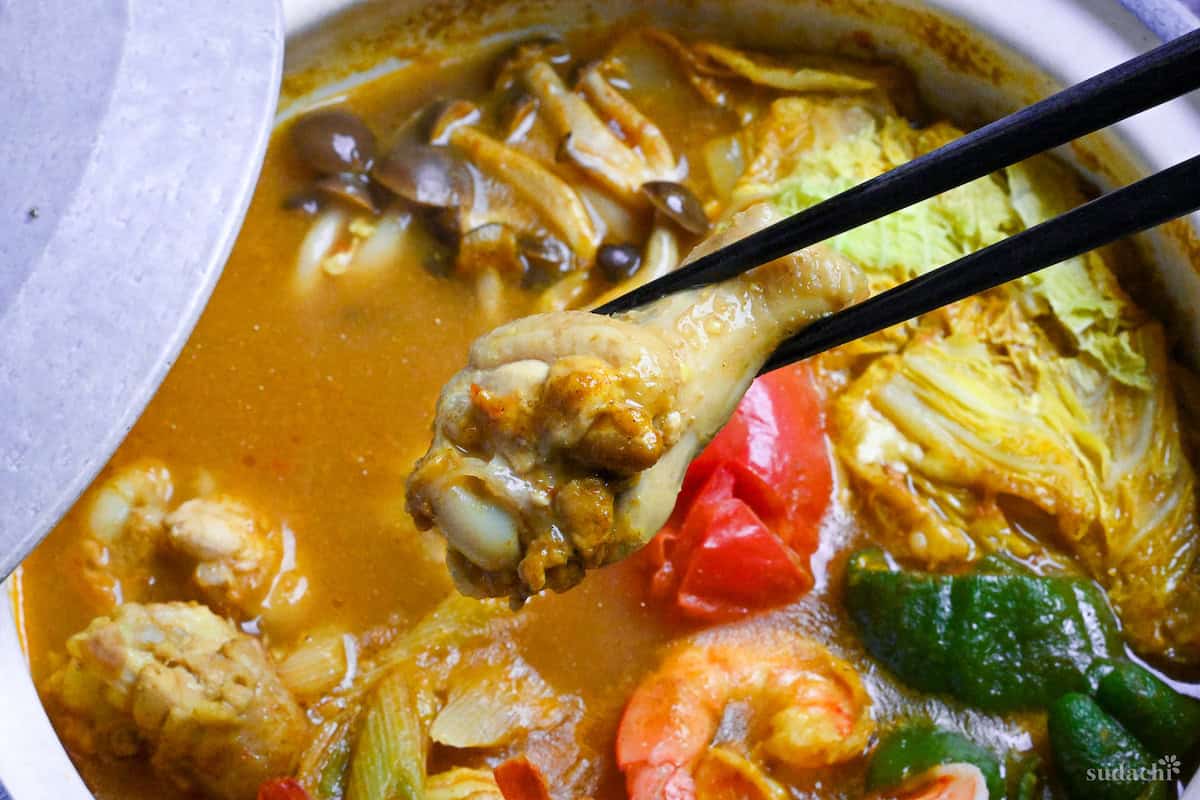
More Hotpot Recipes
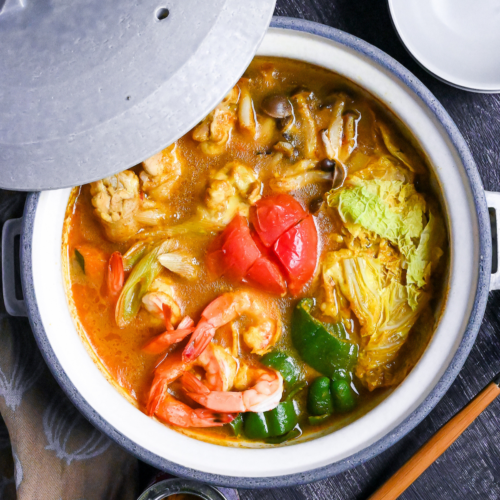
Kare Nabe (Japanese Curry Hot Pot)
Ingredients
- 600 ml water
- 5 g dried kelp (kombu)
- 4 chicken drumsticks
- 1 carrot peeled, cut into thick rounds
- 4 slices kabocha squash (or butternut squash) skin-on
- 1 tbsp curry powder
- 1 tbsp Japanese dark soy sauce (koikuchi shoyu)
- 1 tbsp sake
- 1 tbsp mirin
- ½ tbsp Chinese-style chicken bouillon powder
- 1 tsp chili bean sauce (toban djan)
- 6 black tiger shrimp shells and veins removed, tail left on
- 50 g shimeji mushrooms or mushrooms of choice
- 2 leaves Napa cabbage roughly cut
- 1 Japanese leek (naganegi) diagonally sliced
- 1 green bell pepper or 2-3 piman, cut into bitesize pieces
- 4 tbsp preferred shredded melting cheese
- 1 tomato with a cross scored on the top
- 2 ptns cooked ramen noodles
My recommended brands of ingredients and seasonings can be found in my Japanese pantry guide.
Can’t find certain Japanese ingredients? See my substitution guide here.
Instructions
- Take your cooking pot and add 600 ml water and 5 g dried kelp (kombu). Leave to soak at room temperature for 30 minutes.

- Place the pot on the stove and add 4 chicken drumsticks. Heat until almost boiling, then remove and discard the kombu. Scoop out any scum that floats to the surface of the broth.

- Add 1 carrot and 4 slices kabocha squash. Simmer over medium-low heat for 5 minutes with the lid on. If using additional hardy root vegetables, add them in this step.

- Season the broth with 1 tbsp curry powder, 1 tbsp Japanese dark soy sauce (koikuchi shoyu), 1 tbsp sake, 1 tbsp mirin, ½ tbsp Chinese-style chicken bouillon powder and 1 tsp chili bean sauce (toban djan). Mix until combined.
- Place 6 black tiger shrimp, 50 g shimeji mushrooms, 2 leaves Napa cabbage, 1 Japanese leek (naganegi) and 1 green bell pepper in the broth. Sprinkle the top with 4 tbsp preferred shredded melting cheese and place 1 tomato in the center.

- Cover with a lid and continue to simmer for 5 minutes or until the chicken and shrimp are cooked through and the vegetables are softened to your liking.

- Serve and eat up all of the ingredients in the broth.

- Add 2 ptns cooked ramen noodles to the leftover soup. Enjoy!

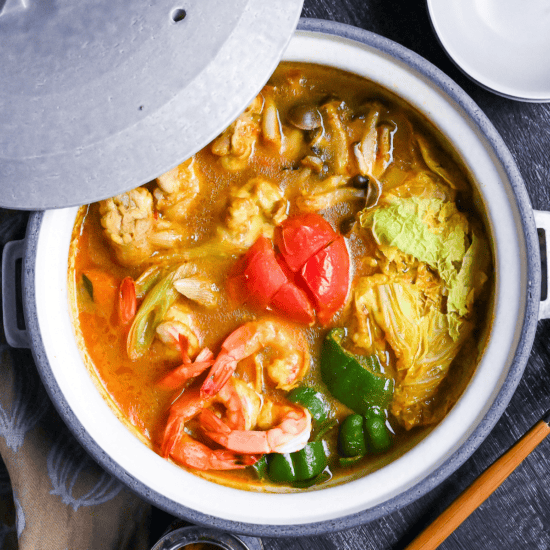



Leave a rating and a comment